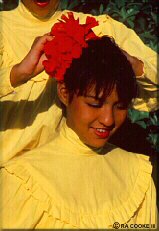PHOTO TOURS – Original Tour – Island Folks
![]()
![]()

A carefully pinned red hibiscus is the perfect compliment to the Hawaiian muumuu as these young ladies prepare for a hula demonstration.
Hula is such an important part of Hawaiian culture that, even here on lightly populated Molokai, there are several hula halau (training schools).
The Kumu Hula, or hula teacher, assembles the dancers, both men and women, boys and girls, in practice sessions weekly. When an occasion arises, the halau is asked to perform.
An “occasion” could be as formal as an international competition or as relaxed as a baby luau, an evening at a local restaurant, or an impromptu get-together in someone’s back yard.
Music is an integral part of the lifestyle on Molokai.
Guitars and ukuleles are always in attendance at local gatherings or parties. As if by magic, they appear at precisely the right time and the music and songs begin.
Here, one member of a very musically-talented Molokai family serenades a group of visitors with Hawaiian tunes in both English and Hawaiian. A frown is impossible when these guys are playing!


Another item as common to locals as the ukulele is fishing nets.
There are several different types of nets, and the one the fisherman chooses is dictated by what kind of fish he wants on the table that day.
This net, called moemoe, is 4 to 5 feet (1.2 – 1.5m) wide and as long as one can afford.
There are floaters attached to one edge of the net, and small lead weights on the other.
It is anchored at one end to the ocean floor, paid out like a fence to form a straight line or a U-shape, and the other end is again anchored.
After a few hours or overnight, the net is gathered and brought to shore. Here, the fisherman reaps his harvest – fresh catch really takes on a new meaning.
Hawaiians have long used ipu (gourds) as receptacles; small gourds with thin walls to hold water or food, larger ones to hold clothing or to serve as drums.
In hula, the ipu can be used is a variety of ways including as a rattle or a drum.
As a drum, it is held in one hand, while the other hand taps a rhythm during a chant. The chant is usually performed by the Kumu Hula as the dancers interpret the meaning of the chant.
Dancers may also hold an ipu and use it to demonstrate another variety of dance.
She wears a head lei of plumeria, distinctive with its bright yellow and white petals and unmistakable scent.

On a walk through Kaunakakai, this is a common sight – two young men, jammin’ music on their ukuleles for anyone to enjoy.
 Ukuleles are not only for Hawaiian music. Reggae, rock, jazz or country are all played on this instrument, often with intricate plucking.
Ukuleles are not only for Hawaiian music. Reggae, rock, jazz or country are all played on this instrument, often with intricate plucking.
The guitar was brought to Hawaii by the Spanish cowboys who were hired to teach the Hawaiians how to ranch.
The ukulele, smaller in size and easier to play, was brought by Portuguese in the 1870s. Ukulele means “leaping flea,” which is exactly what the nimble fingers resemble when playing.
